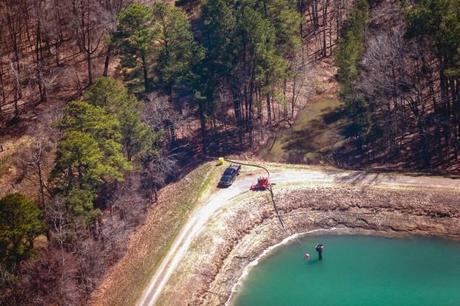
Photographs show Duke personnel using a portable water pump to empty its 1978 coal ash pond. The plant’s Clean Water Act permit only authorizes discharges when the pond level overtops the vertical discharge pipe visible in the photo, in order to reduce discharges of toxic solids in the effluent. Photo: Waterkeeper.org
by Emily Atkin / Think Progress
North Carolina regulators on Thursday cited Duke Energy for illegally and deliberately dumping 61 million gallons of toxic coal ash waste into a tributary of the Cape Fear River, which provides drinking water for several cities and towns in the state.
The incident marks the eighth time in less than a month that the company has been accused of violating environmental regulations. The North Carolina Department of Environment and Natural Resources (DENR) said Duke — notorious for the February Dan River disaster which saw 82,000 tons of coal ash released into state waters — was taking bright blue wastewater from two of its coal ash impoundments and running it through hoses into a nearby canal and drain pipe.
Duke is reportedly permitted to discharge treated wastewater from the ash ponds into the canal, but only if they are filtered through so-called “risers,” pipes that allow heavier residue in the water to settle out. DENR told ABC News on Thursday that Duke’s pumping bypassed the risers.
“We’re concerned with the volume of water that was pumped and the manner it was pumped,” DENR Communications Director Drew Elliot told ABC. “It did not go through the treatment facility as it should have.”
Duke’s most recent incident was discovered after the environmental group Waterkeeper Alliance last week released aerial surveillance photos taken from a fixed-wing aircraft that showed Duke workers pumping wastewater from the two toxic coal ash lagoons into a canal.
Waterkeeper Alliance tried to go to the source of the pollution via boat but were warned off by plant employees and a policeman, so they resorted to aerial surveillance, as seen in this clip from the Rachel Maddow Show on MSNBC.
The toxic water that Duke allegedly dumped is a byproduct of coal ash, a waste product from coal-fired power plants. Coal plants generate millions of tons of waste every year, and that waste is contaminated with toxic metals including lead, mercury, arsenic, chromium, and selenium. More than two-thirds of that waste — called coal ash — is dumped into landfills, storage ponds, or old mines.
The news is just the latest in a string of environmental violations surrounding Duke in the last few months. But Duke is not the only North Carolina entity that has been engaging in questionable conduct. DENR itself has earned a good deal of mistrust from environmentalists in no small part due to its questionable handling Duke’s many serious environmental violations. The U.S. Justice Department has recently opened a criminal investigation into DENR due to its handing of the February Dan River spill, questioning the relationship between the agency and Duke — a company that also was a 28-year employer of Gov. Pat McCrory.
In addition, emails obtained by the Associated Press last week suggested staff at DENR were coordinating with Duke Energy officials before intervening in a suit by citizen groups against the company.
The state has also been in the spotlight in past years for its climate change denial, most notably marked by a law passed in 2012 to stop the use of climate-related science to plan for future events. Specifically, that law forces coastal counties to ignore observations and the best science-based projections in planning for future sea level rise.

